Recording acoustic guitar is an art that can take a little perfecting. When it comes to recording, pretty much every engineer (or just music enthusiast) has their own specific workflow that they develop over time. This often starts with choosing the right equipment.
In this article, we’ve delved into the best microphones for recording acoustic guitar. First, we discuss what makes a microphone suitable and high-quality for recording acoustic guitar, before a rundown of our 10 top mics for this purpose.
We’ve also got a big focus on budget within this post. We know that not everyone is looking to spend a huge amount to get decent results. If you’re reading this you might have a budget of $100, or you may have a limitless budget. We’ve got options within the list suitable for every price range.
The good news is that you don’t have to spend a fortune if you can’t afford to and that it is possible to get a good quality recording with a microphone that you have bought on a budget as long as you choose right and use it right!
What we don’t cover in this article are the best ways and the multitude of ways that you can record an acoustic guitar. While the microphone is clearly an important part of the process it is also paramount to understand what needs to be thought about before recording. In our article How To Record Acoustic Guitar (Phone, Computer, Direct, Amp) we cover what you need to know before getting started.
What to Consider When Choosing Your Mic
To make it easier, we’ve featured a buying guide with all the things you need to consider when you are choosing a microphone. You don’t have to be an experienced studio engineer to make the right choice, but you do need to know some information about how the recording process works and what all of the different terminologies mean when you are buying a microphone, otherwise, it can get very confusing, very quickly. So, what are the key considerations before choosing a mic?
Dynamic or Condenser
These two different types of microphone are the most common you’ll come across when looking for a mic to record acoustic guitar. There are some differences between them.
Generally speaking, dynamic microphones tend to be preferred in live situations. They are more robust and the capsule is less liable to become damaged easily. This means they can stand up to a bit of a beating on stage if you get a particularly rowdy vocalist, for instance.
Condenser microphones are more sensitive, and as a result, are slightly more susceptible to damage. However, it is still not likely that you will experience any damage using them at home, or in a recording studio as long as the mic is treated right. Condenser microphones use technology which requires them to be powered, too. This means that they will have to be connected to a desk or an audio interface which can provide power. The big upside of condenser microphones is their sensitivity, this means they can pick up audio more clearly and are often preferred for recording, especially instruments which aren’t super loud.
Most of the top mics for acoustic guitar are condenser microphones. These are preferred for acoustic instruments for the clarity they can provide. That said, there are some dynamic mics on our list and these microphones have been used for decades and have produced some excellent results.
Polar Pattern
The capsule of a microphone will have its own polar pickup pattern. Think of this as the range that they can hear sounds. There are some very useful diagrams out there to help you better understand the patterns.
Cardioid is the most popular, this picks up sounds directly in front of the mic. However, there are some different patterns. Omnidirectional patterns pick up sound from all around the microphone, meaning if used to record acoustic guitar you will get a recording which features the room too. This is a good way to do it if you want some ambiance in there. A figure of 8 is another popular pattern, this rejects sound from the side of the mic’s input but takes it from the front and back.
There are different mic techniques out there. Cardioid is an option most mics should have and is something to look for. Many mics let you switch the polar pattern which can be a big plus, too.
Diaphragm
Microphones have diaphragms in different shapes and sizes, these give different results. Whether it is small or large is the biggest impact on the mic, and will affect how they should be used.
A small diaphragm microphone is good for close up micing of instruments and it is great for picking up detail. If the small diaphragm is also a cardioid pattern it will reject a lot of the reverberation and you’ll end up with a natural sound of the guitar. Small diaphragm mics are also good at picking up bass frequencies.
Large diaphragm mics have their charms, too. They give a more ambient and overall well-rounded sound. People often use these for vocals and acoustic instruments due to the natural room sound they can provide.
There isn’t an answer to the question of which is better between small and large diaphragm microphones. The fact is that both have their pros and cons.
Is USB Good Enough?
In the world of audio equipment and music tech, there are plenty of people who will warn you away from USB microphones. True audiophile purists will sometimes say that these mics quite simply don’t provide the clarity you need, and can be harder to control. The fact of the matter is that while USB mics can be lacking sometimes in detail (not always), they are incredibly convenient.
For home recordings, having something to take in your guitar case to make good quality demos and even for recording your own compositions, there are some USB microphones which are good enough. We’ve listed some USB options within our list. The plug-and-play compatibility is a hugely beneficial thing for guitarists who want to be able to record with ease. Some of these USB models can even be set up to record onto a phone or tablet, making portability easier than ever.
Frequency Response
Microphones all pick up different frequencies in a slightly different way. Some are simply better suited to record acoustic guitar as the strongest areas where they can pick up frequencies are in the ‘sweet spot’ for the sound of an acoustic guitar. Just like the AKG D112 became known for recording bass, there are certain mics which just have a sweet response for acoustic guitars.
Most microphones will advertise their frequency response as ‘20 hZ to 20 kHz’ or something similar. This is pretty standard. The thing to pay attention to is the graph of all the frequencies which can show exactly where the microphone responds strongest to the frequencies.
Brand
Though it is not the only consideration you should take into account, the brand is definitely something to think about. Certain brands and manufacturers conduct a huge amount of respect in the music industry due to the fact that they consistently make excellent microphones. Off-brand mics can be really hit and miss, but top brands such as Shure, AKG, SE, and others go through rigorous testing for quality and reliability. While you should never pay for the brand name itself, the more expensive brands tend to have excellent components and build quality, and this is worth paying more for. These products will last longer and create lasting results.
10 Best Microphones for Recording Acoustic Guitar
These are the 10 microphones we’ve picked out as being the best microphones. Some of them, we’ve also nominated based on their price. For instance, the ‘best under $100’. This is so that, if you’re on a budget, you can see which microphones you will be able to afford within the price range. So, on to the reviews of the top 10 mics.
Shure SM81-LC Cardioid Condenser Instrument Microphone – Best Mic For Live Acoustic Guitar

The Shure SM81-LC is a popular microphone for a variety of different instruments. It is available for under $400 and for that you truly get a professional microphone suitable for acoustic instruments. Check here the current price of the Shure SM81-LC at Amazon
This is preferred by a lot of musicians and engineers for recording acoustic guitar. The frequency response is really flat, but you can choose to roll off the low-end if you wish so you can just focus on the shine of the guitar. The microphone won’t taint your recordings with any weak areas, it simply provides a realistic and detailed sound.
The Shure brand is one of those that you can trust 99 times out of 100, and the SM81-LC is proof of this.
It is cardioid in pickup pattern so good for detail and rejecting the ambient noise of the room or things like the player’s breathing or moving around. This mic is not the strongest for vocals, and lacks a bit of warmth in this area, but if you just want to record your acoustic guitar in isolation then the SM81-LC is a top choice.
It is a condenser microphone so it requires a source of phantom power with a decent pre-amp to get a good sound level out of this mic.
Samson C02 Instrument Condenser Microphones – Best Stereo Pair Under $200
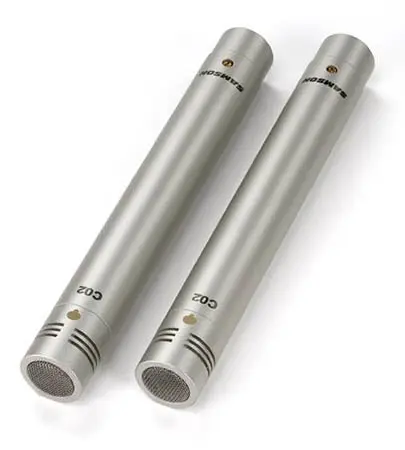
Samson is a brand which is known for budget microphones. The C02 mics are a stereo pair and have built a good reputation due to some really good results. Due to the fact that they are a pair, you will need to use a micing technique that allows you to use both. The stereo nature of this set can give a really full, surround-sound style recording. Click here to check the current price of the Samson C02 at Amazon
The price is very appealing, and these mics can be picked up for a snip when compared to a lot of alternatives. As well as getting a pair of microphones which can be used for drum kits and a variety of other instruments too, you get a carry case and the mic clips needed, too.
The frequency response isn’t as flat as many of the other competing products, but for the price it is hard to argue with the quality on offer. A few users have reported that recording high frequencies may cause an issue. Generally, though, if value-for-money is a priority for you and you are looking to get a stereo pair, we recommend the C02.
Shure SM57 – Best Mic For Recording Acoustic Guitar Under $100

This is a microphone which simply couldn’t be left off our list. This is not a condenser microphone, it is a dynamic mic which does mean it is largely used for on-stage applications. That said, it is also one of the most versatile and well-rounded mics which can be purchased on a budget. For this reason, it is hard to find recording studios around the world which don’t have at least one SM57 kicking around somewhere. They’ve been industry standard for decades. Check here for the current price of the Shure SM57 at Amazon
The cardioid pickup pattern does a good job of rejecting other unwanted sounds and focusing on the guitar itself. Our ears are very used to hearing things recorded with the SM57 as it is so popular, and though it could arguably be a little bit more detailed to make it the perfect option, it is very good at recording a number of different instruments and good to have around. It doesn’t require phantom power as it is a dynamic option. The frequency response is contoured which means it rolls off the lower end and bass frequencies in order to better serve the higher end and the shine of instruments such as acoustic instruments and electric guitars.
Rode NT4

Stereo recording can be a brilliant way to get a detailed acoustic guitar sound, but a lot of people don’t have the capacity to set up multiple microphones (for instance, an audio interface may just have one XLR input). Also, multiple mics can cause issues around phasing. Click here to check the current price of the Rode NT4 at Amazon.
For the benefits of stereo recordings without having the hassle, you can go for the Rode NT4. This has two capsules within it, which is pretty unique for a microphone. The clarity is exceptional, and getting a full, well-rounded sound from a single microphone (technically) has never been easier.
This microphone needs phantom power, but this can be provided from a 9V battery if needed, making portable recording far more easy to do than many other condenser microphones. The connection is not just suitable for use in an audio interface or mixing desk and this comes with all you need to plug into a camera or even laptop if needed.
The NT4 costs a little more than many of the other choices, and you won’t find this first hand for under $500. That said, you’re effectively getting two mics in one!
Audio-Technica AT2020 Cardioid Condenser Studio XLR Microphone – Best Under $200
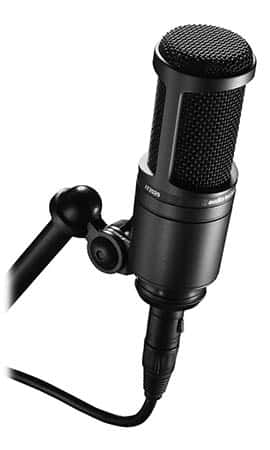
The AT2020 is such a good option if you need a compromise between quality and value. It can be purchased for under $200, and has a surprising set of features when you consider the relatively low outlay to buy. Check here for the current price of the AT2020 at Amazon.
The microphone comes with a case and microphone clip so you can get started as soon as it arrives. This is a really good choice for vocal recordings of all kinds, but also does a stellar job when it comes to recording good quality acoustic instruments. The vocal strengths have led to this mic being used a lot by podcasters and singers, but acoustic guitars respond very well to the mic, too.
A very wide dynamic range means this is suitable for lots of different uses, and gives a clear response for the low-end of the guitar all the way up to the high. Whether you’re playing bassy chords or soloing near the body. The high SPL also means this responds well to loud playing and doesn’t distort if you want to record at a higher volume.
This mic is popular due to the fact it can let you record vocals very easily after recording your guitar, something a lot of singer/songwriters love to do.
AKG C451B – Best Small-diaphragm Condenser Mic for Acoustic Guitar

AKG is a wonderful brand. German engineering and decades of history make this a top choice for studio mics and the C451B is one of the many options which can provide great acoustic guitar recordings. To give a little frame of reference, this is the guitar microphone preferred by engineers working with Jack Johnson. Check for the current price of the AKG C451B at Amazon.
The C451 microphone is iconic, and was released in the late 60s and used extensively after this. The C451B was brought out in 2001 and has even better electronics. It is a small diaphragm mic and is good for loud sounds, recording up to 150 decibel sound sources with no issues. This is a good choice for micing your guitar relatively close up and will do a good job of rejecting other sounds due to the cardioid pickup pattern.
Clarity is one of the biggest plus-points of this microphone. Though it isn’t a good choice for people who are on a tight budget, it gives a really great sparkle to an acoustic guitar if you’re happy to invest in the microphone.
Blue Yeti USB Microphone
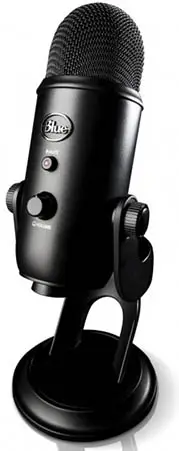
A lot of people looking for a microphone to record acoustic guitar quickly and easily are in the market for a USB product that can just plug in and be ready to use. A lot of these USB products will let you down with the clarity, but Blue is a brand which continues to get USB mics right. The Blue Yeti has grown to be hugely popular as the manufacturer have called it ‘The Mic of the Internet’. Check here for the current price of the Blue Yeti at Amazon.
This is another mic which has proven to be very popular for use for voice applications, whether singing or recording voiceovers or other speech. The Blue Yeti comes with its own stand and instant connectivity with mac iOS and Windows.
One of the best things we’ve found about this particular microphone is the fact that you can switch between four different polar patterns, meaning you can experiment and choose the one which best suits your needs. Cleverly, you can instantly monitor with a headphone output which comes directly out of the microphone, something that lets a lot of USB mics down.
Though some purists think USB mics are a bit of a let down, recodings made on the Blue Yeti or other Blue microphones are starting to creep into commercial recordings. This is a great option if you want to minimize the hassle.
Sennheiser E609 Super Cardioid Microphone
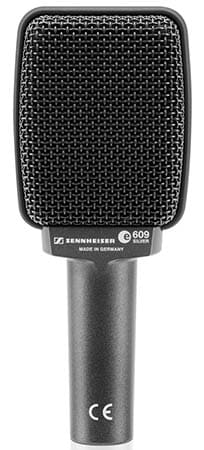
Sennheiser is another very reliable manufacturer of microphones. They make other gear, too, and you may well have heard of Sennheiser for their huge range of headphones.
The E609 is a super cardioid model meaning it is good at focusing in on one particular sound source, it can also handle high volumes and while we definitely recommend it as one of the very best mics for electric guitar, it is suitable for acoustic guitar, too. Check here for the current price of the E609 at Amazon.
One of the reasons this is so good for electric guitar is the hum-compensating electrical coil which cuts out lots of the interference you can get from amps or other electrics. If you’re recording onto a laptop or any other device, though, this can be an issue for all sorts of recording.
The flat face shape makes this easy to point in the direction you want, and it iss very rugged and durable with a 10-year warranty offered by the manufacturer. The E609 is excellent at picking up frequencies between 40 hZ and 18 kHz, and while some mics have a wider response, you won’t need to record anything below 40 hZ from an acoustic guitar!
AKG C414

Yet another microphone made by AKG. The brand really is one of the most impressive manufacturers of microphones you’re likely to come across. The AKG C414 is described by many as being a legendary mic and we would have to agree. While you wont get much change out of $1,000, it has all the features to back up the cost. Check here for the current price of the AKG C414 at Amazon
Few microphones give so many choices on the mic itself. The controls allow you to change between an unbelievable nine different polar patterns just with the flick of a switch. There are also three different bass frequency roll off options if you want to focus on the higher frequencies.
The mic comes with a high-quality carry case, a windshield, pop filter, and a shock mount to attach to any mic stand.
This is a microphone which is hard to fault when recording most instruments, it’s dynamic and frequency responses are brilliant and it is suitable for acoustic guitar, electric guitar, piano, vocals, drum overheads and more.
Because of the huge control you have with the C414, it can be your best friend when you come to record your guitar. You can choose whichever of the pickup patterns most sweetly reproduces your guitar and suits the room you are in.
The manufacturer also offer a cheaper version. The AKG C214 is similarly designed with a little less quality and not quite the same level of control. However, if the C414 is well out of your budget, and you would like something that’s similar, but comes in at under $500, the C214 is worth looking into.
Rode NT1 – Best Large Diaphragm Condenser Under $300
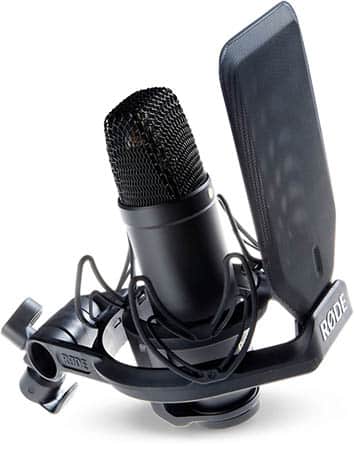
The final product on our list is the Rode NT1. Rode is a wonderful brand and while some of the products they manufacture are a little more expensive, the NT1 is great value. It really punches above its weight and has audio clarity you would expect from a microphone twice as expensive.
This is a cardioid mic with exceptionally low self-noise meaning that you can record all the dynamics of a guitar, from the tiniest fret noise to loud strums. The sound is always detailed and the frequency response is clear from low bass sounds to high frequency soloing.
This mic is truly best for either vocals or guitar, making it a top choice for singer-songwriters and a good addition to most recording studios. The Rode NT1 comes with shockmount, pop filter, a cover and even the XLR cable you will need for the output. Check here for the current price of the Rode NT1 at Amazon.
The manufacturer has also seen the need to offer a product which can be used via USB and have made the NT-USB in a similar ilk and design to the NT1-A. This can easily be plugged into a laptop and start recording with minimal fuss in a matter of a few minutes.
Conclusion
As you can see from our list of the best mics for acoustic guitar, there are plenty of different options out there. If budget were no object we would usually recommend the AKG C414, but any of the options we’ve listed can do the business if they are used in the correct way, in the right environment and on the right acoustic guitar.
Buying the right guitar for recording can make a great deal of difference. If you want to know what the best acoustics guitars are for recording we go in to the detail here 5 Best Acoustic Guitars For Recording.
Whichever option you choose out of those above will be fine, provided you take the time to learn about micing techniques and how to use it for the best outcome; clear, crisp audio.
